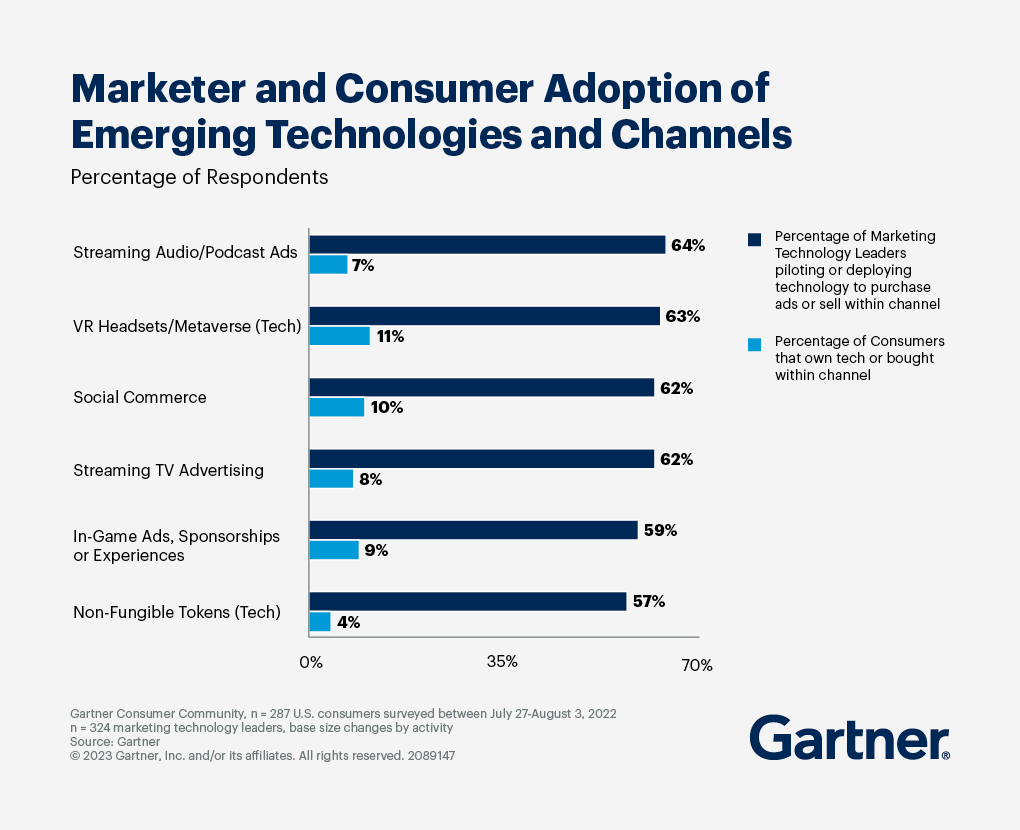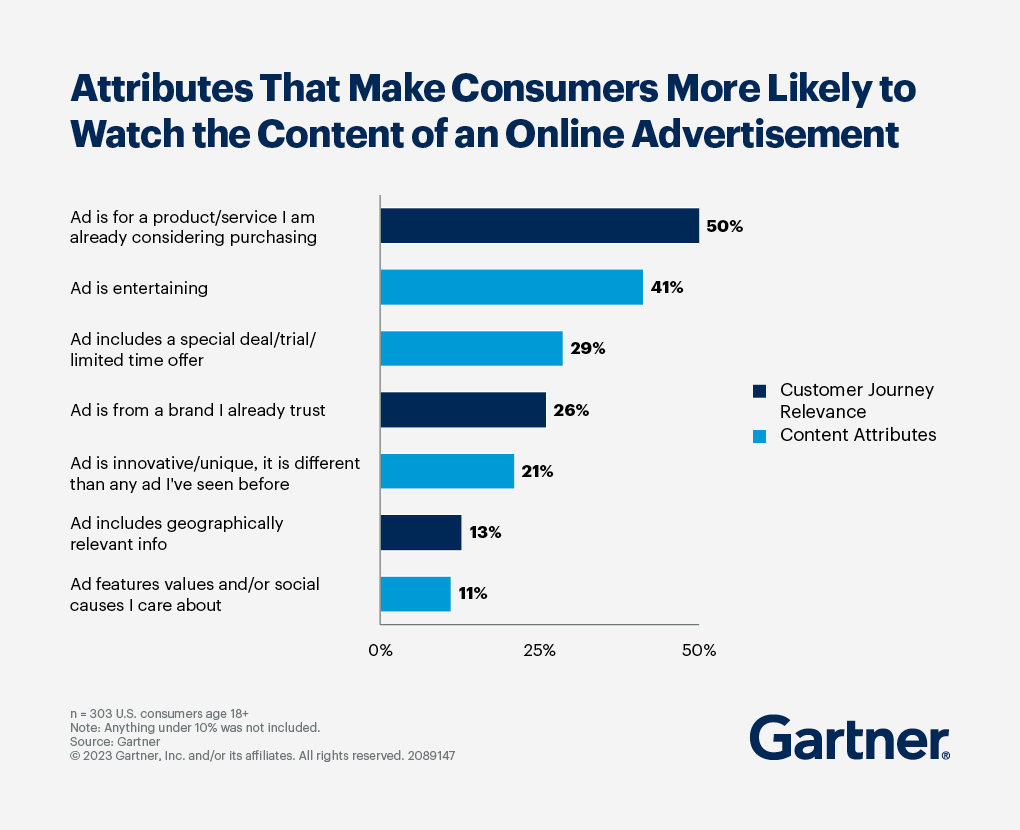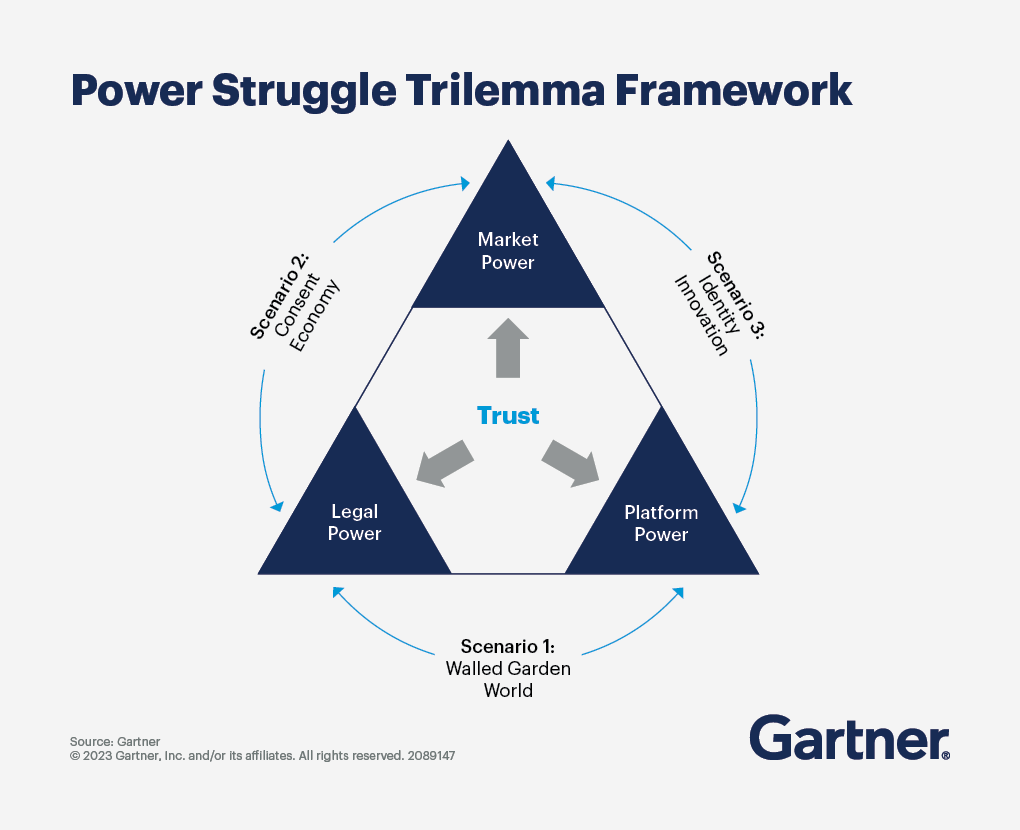Utilize these best practices for successful ad strategies in a volatile world.
- Gartner client? Log in for personalized search results.
Advertising: Optimize Your Strategy for Greater Results
Create a digital advertising plan that meets the challenges of a changing world
Shifts in the media landscape — from the deprecation of cookies to inflation and supply chain disruption — have created uncertainty among advertisers.
Explore our digital advertising guide for insights on:
Emerging trends in web-based digital advertising
Key themes drawn from 1,200+ digital advertisers across six sectors
Winning tactics by competitors and cross-industry peers
Navigate advertising disruption in three critical areas
Tackle challenges, assess new opportunities and deliver clear, measurable results as you plan, execute and optimize your digital advertising strategy.
- Media and Martech
- Digital Video
- Data Privacy
Rightsize ad tech and other strategic investments in line with customer interest
Ad campaigns and investment in emerging channels play a major role in elevating a brand and engaging new customers. In a volatile economy and market, successful marketers focus on advertising techniques that simplify buying and measurement, avoid wasted spend and add to the overall customer journey.
Several factors can influence the media and martech decision process:
The availability of new or existing audiences
The ease of extending existing digital advertising plans to new channels
- The impact on both short- and long-term business objectives (e.g., sales and brand awareness goals)
We conducted two surveys — one of marketing technology leaders and one of U.S. consumers — and discovered deep differences between the two groups’ adoption of emerging channels such as connected TV advertising, in-game advertising, the metaverse, non-fungible tokens (NFTs), streaming audio (including podcasts), and social commerce.
On the one hand, more than half of martech leaders have deployed or are running pilot programs in key technologies that enable new digital marketing channels.
On the other hand, fewer consumers expressed an interest in buying or interacting with brands in these channels.
The take-away? Evaluate emerging channels for their impact on long-term branding, short-term performance/sales goals and existing customer journeys and learning paths. One or both of the following frameworks can help you rightsize your digital advertising investment.
Evaluate impact on branding and sales goals.
Being first to act on emerging media channels can create a short-term advantage in brand awareness and sales. But the advantage can be fleeting, which is why it’s essential to evaluate channels in the context of your existing advertising strategy.
In the short term, prioritize channels that your target audience is adopting and where a brand presence can be bought without additional investment, such as in-game or streaming TV via programmatic buying.
In the long term, develop a strategic roadmap of emerging channels’ impact on the business, such as increasing brand awareness, selling digital products and services, and providing customer service. Start with a proof of concept (POC) to test channel-specific advertising campaigns, then gradually take ownership as channels become more strategic.
Evaluate impact on customer journey and learning paths.
If brand and performance evaluations are inconclusive or the channel is too new, this is your next step.
Adding new channels to an advertising strategy can overcomplicate the customer journey, leading to cart abandonment, churn, lack of loyalty and smaller overall purchases. And mapping the entire customer journey for the sake of capitalizing on an emerging channel isn’t always an option. As an alternative, ask whether the new channels contribute to seamless, prescriptive or learning paths along the customer journey.
Seamless paths provide a consistent experience across channels.
Prescriptive paths provide personalized recommendations.
Learning paths deepen the customer’s understanding of how to accomplish their goals.
Customers who report learning something new about their own needs and goals are 1.73 times more likely to buy more than expected. So it pays to look for ways to integrate self-reflective learning into your digital advertising strategy.
Adjust your video advertising strategy to reflect shifts in media consumption
Consumer habits have evolved considerably in the two years since the pandemic, from all-digital to hybrid shopping. Accordingly, video consumption has ramped up, from exercise and DIY videos, to viral videos on social media, to live streams of video gamers in action.
We analyzed brands’ paid video efforts on desktop screens, and 2021 showed substantial increases in desktop video advertising impressions. However, 2022 brought a reversal, with advertisers slowing their desktop video ad impressions at a negative compounded monthly growth rate (CMGR) of 11% from July 2021 to June 2022.
To translate video impressions into business results, consider the following tips:
Serve a defined purpose and audience. Successful video advertising typically focuses on one of three angles: the organization’s brand story, products and services, or testimonials.
Align with consumers’ preferences and values. When asked about what attributes would be most likely to get them to read or watch online advertisements, respondents in our consumer community highlighted these attributes:
Relevancy. Make ads more relevant by leveraging customer behavior triggers (such as a person’s interests, location or context) to deliver contextually personalized elements.
Entertainment value. If you interrupt a customer’s experience with a video ad, entertaining them is a great way to minimize the disruption. In fact, 41% of consumers are more likely to watch the content of an online advertisement if it entertains them.
Brand recognition/preference. Customers are more likely to pay attention to a video ad if it’s from a brand, product or service they’ve already considered buying or trust.
Lean on user-generated content. Our research revealed that “authenticity” is among the top three values U.S. consumers identify with most. This suggests that consumers may relate more deeply with less-perfect video ads that highlight normal people in natural settings. User-generated content is a great way to achieve this style — and at a lower production cost.
Extend the usability of video ads by repurposing content. Video advertising can be a massive undertaking. Maximize your ROI by reusing modular parts of a single video ad to fit multiple platforms, devices and viewing habits.
Keep digital campaigns and ad-targeting data effective and privacy-compliant
Digital advertising is vital for the success of modern brands, but the deprecation of the cookie and legal restrictions on third-party data will change how ads are bought, targeted and measured.
To help prevent major disruption, assess your digital advertising’s exposure, identify your customer marketing data profile, and prepare for any or all of the following scenarios:
Walled gardens. Customer data that resides within walled gardens (giant, consumer-facing digital platforms such as Google, Facebook and Amazon) stays there. Establish baseline key performance indicators (KPIs) for consistency among walled-garden platforms and adopt platform-based analytics tools to assess and optimize platform-specific marketing performance.
Consent economy. Encourage customers and prospects to share relevant data by offering transparency, control and credible value propositions. Develop privacy and preference controls where consumers can view and modify their profiles, and establish consent-based data relationships with partners under well-defined governance.
Identity innovation. Ramp up participation in pilots and collaborations that explore potential innovations in audience addressability — especially in emerging decentralized environments. Develop a scalable process for pilot program design, approval, execution and evaluation that prioritizes testing of new solutions to marketing identity.
A promising development in the data privacy world is synthetic data. The process behind anonymizing and sharing real first-party data has historically been time-intensive and expensive. Synthetic data can be created securely and efficiently based on an original “real data” set, but without any personally identifiable information (PII) or sensitive data. Once created, the synthetic data can’t be directly deanonymized or traced back to individuals. Because this tool can anonymize data within innovative advertising technologies, it’s worth keeping an eye on as data privacy regulations unfold.
In addition to privacy and regulator pressure, there is strong economic pressure on the industry to adopt a new, common foundation of rules and standards for targeting and measuring ads. To help you navigate and retain market share, it’s critical to understand not just the forces vying for control over the rule-making process, but also their implied outcomes.
Three centers of gravity — legal, platform and market power — are exerting asymmetrical forces on the foundations of addressable advertising. This “trilemma” framework can help you construct scenarios based on the assumption that, where three forces are in conflict, scenarios that satisfy two out of three are more likely to emerge than those that satisfy just one.
Experience Marketing and Communications conferences
Join your peers for the unveiling of the latest insights at Gartner conferences.
Related resources
FAQ on advertising strategy
How can you optimize advertising strategy for maximum ROI?
As budgets decrease, data regulations change and consumer behaviors continue to evolve, marketers can optimize digital advertising performance by understanding disruptive trends and adopting a flexible, video-focused strategy that meets audiences at the digital platforms they prefer.
How do you measure the success of an advertising campaign?
Campaign measurement is not an exact science, and approaches can vary widely depending on the campaign goals and time frame. Successful marketers begin by:
Mapping out potential user paths
Connecting customer actions to desired business outcomes
Ensuring that appropriate tracking and tagging are in place to collect data in aggregate or tie specific customer actions to business results
What is ad tech, and how does it work?
Ad tech refers to technology platforms that enable marketers to manage digital advertising across channels and devices — such as display, video, streaming TV and audio, in-app (including games), social, and search. The use of ad tech platforms can simplify campaign planning, media buying, advertising analysis, optimization and automation.




